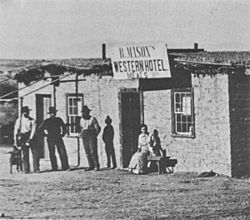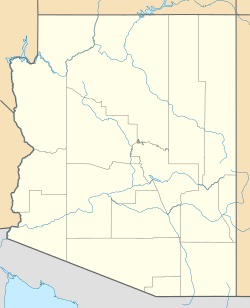Contention City, Arizona facts for kids
Quick facts for kids
Contention City, Arizona
|
|
|---|---|

Mason's Western Hotel in Contention City, 1880.
|
|
| Country | United States |
| State | Arizona |
| County | Cochise |
| Founded | 1880 |
| Abandoned | 1888 |
| Named for | Contention over ownership of a silver claim |
| Elevation | 3,799 ft (1,158 m) |
| Population
(2009)
|
|
| • Total | 0 |
| Time zone | UTC-7 (MST (no DST)) |
| Post Office opened | April 6, 1880 |
| Post Office closed | November 26, 1888 |
| GNIS | 24378 |
Contention City was a busy mining town in Cochise County, Arizona. It was a "boomtown" that grew very quickly in the early 1880s. People came here hoping to find silver. The town was named after a disagreement over who owned a silver mine.
Contention City was an important place for processing silver from nearby mines. But like many boomtowns, it didn't last long. By the late 1880s, it was mostly abandoned. Today, Contention City is a ghost town, with only a few old foundations left. It reminds us of Arizona's exciting silver rush days.
Contents
Contention City: A Silver Rush Ghost Town
How Contention City Began
The story of Contention City starts with two prospectors, Ed Williams and Jack Friday. One night, their mules wandered off from their camp. The next morning, as they tracked the mules, they noticed something shiny. A chain dragged by the mules had scraped away dirt, revealing a lot of silver!
This discovery led to the Contention and Grand Central mines. Another famous prospector, Ed Schieffelin, felt these mines were in his area. He argued over who owned the land. In the end, the claim was split. Schieffelin got the lower part, which he named the Contention Mine. This name came from the "contention," or argument, over its ownership.
Building a Town for Silver
Contention City was founded in 1879. It was built next to the San Pedro River. This location was chosen because silver mines near Tombstone didn't have enough water. Water was needed to process the silver ore.
Two large mills were built in Contention City: the Sunset Mill and the Contention Mill. These mills would "stamp" the silver ore. This means they crushed it into a fine powder. This powder was then ready for the next step, called smelting.
Life in a Busy Boomtown
After the mills were built, the town was planned out in September 1879. Land lots sold very quickly. Within a few months, over a hundred people lived there. The Contention City Post Office opened on April 6, 1880.
At its busiest in the mid-1880s, Contention City had many businesses. There was a saloon, the Western Hotel, and a blacksmith. You could also find a butcher shop, several general stores, and a Chinese laundry. The town was a stop for stagecoaches going to Tombstone and Tucson.
In 1882, a railroad depot was built. This connected Contention City to other towns like Benson and Fairbank. By 1884, the town's population was estimated to be around 200 people.
Famous Visitors and Events
Contention City saw some exciting moments during its short history. After the famous Gunfight at the O.K. Corral in Tombstone, Ike Clanton tried to have Wyatt Earp and Doc Holliday put on trial here. However, no trial ever happened in Contention City.
The town was also a stop for stagecoach passengers. In March 1882, the railroad reached Contention. This made it easier for people to travel. After his brother Morgan was killed, Wyatt Earp brought Morgan's body to Contention. From here, it was sent by train to California for burial. Wyatt Earp and Doc Holliday also used the Contention train station to help the injured Virgil Earp travel.
Contention City was also the scene of a dramatic event involving lawman John Horton Slaughter. In 1886, Slaughter was the sheriff of Cochise County. He was looking for members of the Jack Taylor Gang. He learned they were hiding in Contention City. When Slaughter and his team raided a house, a conflict broke out. Slaughter was injured but managed to stop some of the outlaws. This event helped bring an end to the Jack Taylor Gang.
Why the Town Disappeared
Contention City's importance began to fade. In late 1882, the railroad was extended to Fairbank, which was closer to Tombstone. This made Contention's train depot less important.
Also, water was discovered in Tombstone itself. This meant mills could be built closer to the mines. The biggest blow came in 1886 and 1887. The Contention Mine and other silver mines in Tombstone flooded after an earthquake. This forced the mills to close down.
People started to leave Contention City. The post office closed on November 26, 1888. By 1890, most of the town was gone. Only a few local ranchers remained.
What's Left Today
Today, Contention City is part of the San Pedro Riparian National Conservation Area. This area is looked after by the Bureau of Land Management. If you visit, you can still see some scattered adobe walls. There are also old cellar holes, rows of fence posts, and parts of a small cemetery. Visitors can hike to the townsite along paths next to the San Pedro River.
Location
Contention City is located on the east bank of the San Pedro River. It is about 4 miles (6.4 km) north of the ghost town of Fairbank.
Contention City in Stories
- The town is featured in the first chapter of The Bounty Hunters. This was a 1953 western novel by Elmore Leonard. His story “Three-Ten to Yuma” is also set here.
- Contention City is the setting for the end of the 1957 movie 3:10 to Yuma. It also appears in its 2007 remake.
- In the 1994 film Wyatt Earp, Wyatt Earp and his family catch a train at a station called "Contention."


